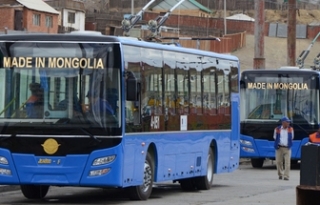ID :
316078
Mon, 02/03/2014 - 11:06
Auther :
Shortlink :
https://oananews.org//node/316078
The shortlink copeid
MADE IN MONGOLIA TO UPGRADE STEPPE ECONOMY

Ulaanbaatar /MONTSAME/ “Made in Mongolia” trolleybuses bump along Peace Avenue, Ulaanbaatar’s main east-west axis, alternating lousy braking with sudden acceleration.
Most of their major components have been imported from abroad and the buses are only assembled locally. Still, they embody the ambition of local authorities to develop Mongolian industry.
“Before, we were thinking of importing everything. But things have been changing and today Mongolians can produce themselves, even buses,” said president Tsakhia Elbegdorj during the inauguration of a new bus assembly line in Ulaanbaatar few weeks ago.
Better known for its nomadic people and untouched steppe, Mongolia has never been a manufacturing centre. National hero Chingis Khaan waged war against the richer kingdoms lying south of the Gobi desert, enticed by the flow of goods along the ancient Silk Road, most of which were unknown to the Mongol tribes of the steppe.
Mongolia still imports most of the goods it needs. Its exports are almost exclusively the raw fruit of its booming mining industry, which command prices much lower than finished goods. In 2013, the country’s trade deficit was $2.08 billion and its current account was equal to almost 30 per cent of GDP, the highest in Asia, according to the World Bank.
Facing such imbalances, the government is trying to shift its focus beyond the mining sector to diversify the economy and reduce its vulnerability to external shocks. Some MNT 1,000 billion togrog ($540 million) have been pledged to back export-oriented production and make 2014 the “Year of Made in Mongolia”.
But with a population of just 2.9m people and close neighbours that include the global industrial powerhouses of China, South Korea and Japan, it does not make much apparent sense for Mongolia to develop a large manufacturing base.
“Export development is constrained by comparatively high costs for skilled labour and weak value chains in some industries,” Jan Hansen, the Asian Development Bank’s senior country economist, told beyondbrics. In other words, Chinese machinery, South Korean electronics and Japanese vehicles will outmarket Mongolian goods in almost any circumstances.
To make things worse, Mongolia faces the classic symptoms of Dutch disease: as resource exports rise, so too will the value of its currency, driving down competitiveness in other sectors.
But there is one industrial sector that offers hope: Mongolia has plenty of room for upgrading the value of its animal husbandry, which so far has little presence on international markets.
“The elevator for Mongolia’s industrial strategy is through developing premium priced exports linked by an overall marketing proposition,” says Stephen Kreppel, director of the national marketing office, who is drafting a marketing strategy to counter Mongolia’s heavy reliance on mining exports.
Mongolia’s untouched steppe has been a perfect setting for generations of nomadic herders and their animals. Today, the country boasts one of the world’s largest endowments of livestock, with 45m head of sheep, goats, cattle, horses and camels. If production processes were able to preserve the uniqueness of its animal husbandry – not yet the case by any means – Mongolian meat, cashmere, wool and diary products would have the potential to reach wealthy consumers in China, central Asia and the west, commanding premium prices, Kreppel believes.
As local businesses work on coming up with a premium Made in Mongolia brand, the mining industry also has the chance to upgrade its processes. Today, raw copper, iron ore and coking coal are shipped to China, only to be bought back as refined copper products and steel. Authorities hope the planned Sainshand Industrial complex will change this. Located between the mines Oyu Tolgoi and Tavan Tolgoi and the oil fields in Mongolia’s eastern provinces, the complex entails the construction of an oil refinery, a copper smelting plant, a construction material factory and a steel and metallurgical plant. Total investments are expected to reach $10 billion, according to a feasibility study by US engineering firm Bechtel--itself a big challenge for a $12 billion economy.
Mongolian steel bars or premium cashmeres will not hit the international markets any time soon. But today the government has the chance to express its leadership through a comprehensive industrial vision – or perhaps clumsy trolleybuses will remain the sole legacy of the Made in Mongolia dream.





